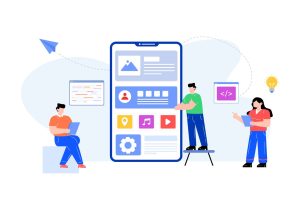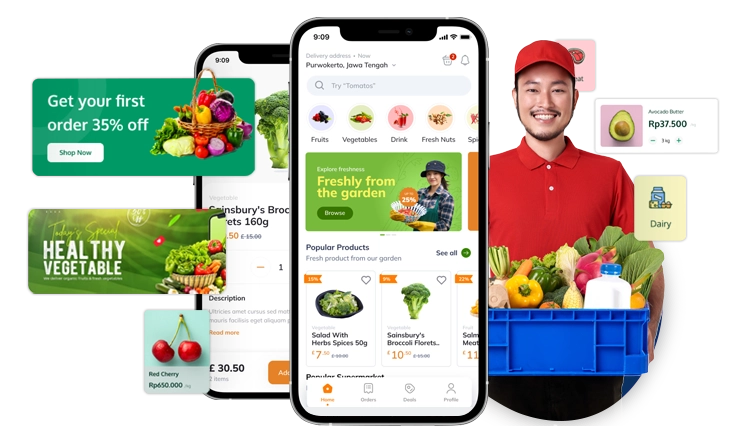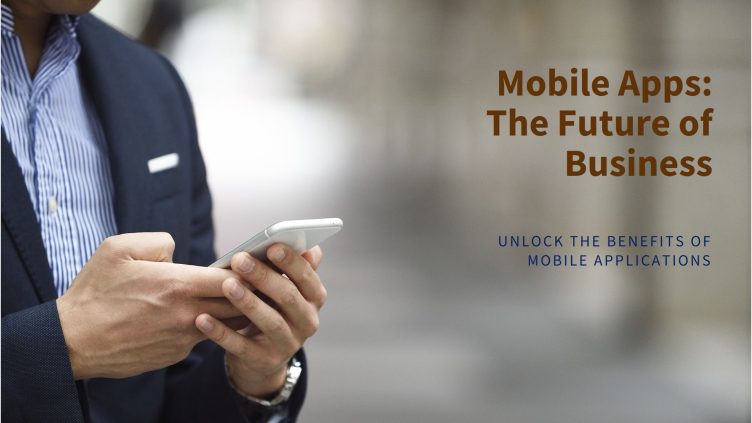In 2024, a grocery delivery app development project remains a lucrative business opportunity. The reason is simple: with global digitalization, online shopping has become a standard practice for all customer segments, including older adults. With a convenient and user-friendly app, grocery shopping is no longer a chore but a simple task that can be completed within minutes.
According to data from Statista, 58 percent of millennial consumers in the UK would buy grocery products mostly via e-commerce. At the same time, by 2025, the average annual spend per online grocery customer in the US will increase to $1,524.84 from $856.47 in 2021.

Is a grocery delivery app profitable?
As the name suggests, grocery delivery apps let customers order groceries (or other products) to be delivered to their doorstep. The food delivery market already has tons of platforms to offer. So, why can a grocery delivery app development project be profitable? Here are three reasons.
Investing in a rapidly growing industry
The demand for grocery delivery services continues to grow. Based on data from Statista, the grocery delivery market worldwide is expected to reach $1,271.00 billion by 2028, growing at a compound annual growth rate (CAGR) of 12.74% between 2024 and 2028.
Moreover, according to The Business Research Company’s report on the online food delivery market, the growth of this market is closely tied to the increase in the working population, especially young workers in metropolitan cities. With more and more people working in metropolitan areas, the rise of disposable income, and the accessibility of the internet, the demand for food delivery services will continue to grow steadily.
Estimated online food delivery market size worldwide from 2022 to 2027
Improving the grocery shopping experience
Ordering food online and getting it delivered is obviously faster than actually going to the supermarket. On the app, you are not wasting time searching for the right products, waiting in lines, etc. And avoiding the hassle is a game changer for those who work full-time shifts. Besides, often customers in physical grocery stores can only pay with a credit or a debit card, while apps usually offer multiple payment options, like RFID cards and EMI options.
Basically, it all comes down to the fact that online grocery shopping makes life a little easier for customers, and that’s why they will continue choosing it over physical stores.

How to Build a Grocery App Like Instacart ?
Building a grocery app like Instacart involves several steps, from understanding the business model and market needs to designing and developing the app. Here’s a comprehensive guide:
1. Glimpse Into Instacart Grocery App
Instacart is a popular grocery delivery service that connects customers with personal shoppers who pick up and deliver groceries from local stores. Key features of Instacart include:
– User-friendly interface
– Real-time inventory
– Multiple payment options
– Delivery scheduling
– Customer support
2. How Does The Instacart App Work?
Instacart operates by following a streamlined process:
1. User Registration/Login: Users create an account or log in.
2. Location Selection: Users enter their delivery address.
3. Store Selection: Users choose from a list of available stores.
4. Product Search and Selection: Users browse or search for products and add them to their cart.
5. Order Placement: Users review their cart and place the order.
6. Payment: Users pay via various payment options.
7. Order Fulfillment: A personal shopper picks the items and prepares them for delivery.
8. Delivery: The order is delivered to the user’s address.
3. How to Build a Grocery App Like Instacart?
Step-by-Step Guide:
1. Market Research and Planning
– Identify your target market and competitors.
– Define your unique selling proposition (USP).
2. Define Features and Functionality
– User Side: Registration, profile management, store and product search, cart management, payment gateway, order tracking, reviews and ratings, push notifications.
– Admin Side: User management, store management, product management, order management, payment management, analytics and reporting.
– Shopper Side: Order management, navigation and route optimization, in-app communication, earnings tracking.
3. Choose the Technology Stack
– Front-end: React Native, Flutter for mobile apps.
– Back-end: Node.js, Ruby on Rails, or Django.
– Database: PostgreSQL, MongoDB.
– Payment Gateway: Stripe, PayPal.
– Cloud Services: AWS, Google Cloud.
4. Design the User Interface
– Create wireframes and prototypes.
– Focus on a user-friendly and intuitive design.
5. Development
– Front-end Development: Build the user interfaces for iOS and Android.
– Back-end Development: Set up the server, database, and APIs.
– Integration: Integrate front-end with back-end services and third-party APIs.
6. Testing
– Conduct unit testing, integration testing, and user acceptance testing (UAT).
– Perform beta testing with a group of real users.
7. Deployment
– Deploy the app to the App Store and Google Play Store.
– Set up cloud infrastructure for back-end services.
8. Post-Launch Activities
– Monitor app performance and user feedback.
– Regularly update the app with new features and improvements.
4. How to Make Money from Grocery App?
Monetization strategies include:
– Delivery Fees: Charge a fee for each delivery.
– Service Fees: Charge a percentage of the order total.
– Subscription Model: Offer membership plans for free or discounted deliveries.
– Advertising: Allow brands to advertise within the app.
– Partnerships: Partner with local stores and take a commission on sales.
5. Measures to Take Amid Pandemic
– Contactless Delivery: Implement no-contact delivery options.
– Health and Safety Protocols: Ensure all shoppers follow health guidelines.
– Real-time Inventory Updates: Keep inventory updated to avoid stockouts.
– User Communication: Keep users informed about delivery times and delays.
– Enhanced Support: Provide robust customer support to handle increased demand.
6. Life of Grocery Apps After COVID
– Sustained Demand: Continued high demand for grocery delivery services.
– Hybrid Shopping Models: Combination of in-store and online shopping.
– Technological Advancements: Increased use of AI, machine learning, and IoT for personalized shopping experiences.
– Expansion of Services: Offering more diverse products and services beyond groceries.
By following these guidelines, you can build a robust grocery app similar to Instacart, cater to user needs, and create a profitable business model.
Look No Further If You Already Have An Idea For Your Grocery Delivery App

About Author
Mehran Baloch
Mehran Baloch is visionary CEO of Sieg Partners – Top mobile app and software development company based in Ahmedabad India. Mehran is a friendly and dedicated leader who loves exploring new ideas in emerging technologies such IOT, AI., Blockchain and more. Mehran’s smart thinking and love for learning about the latest technology trends have helped Sieg Partners succeed quickly and client with great solutions. He always makes sure clients and team stays updated on what’s new in the tech world. Mehran is great at solving problems and working well with others, which everyone appreciates.









